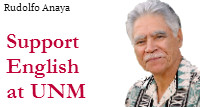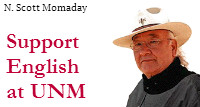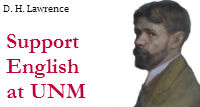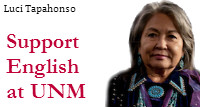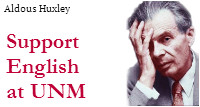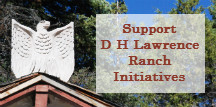Spring 2022 Course Descriptions
Face to Face, W 1600-1830
Belinda Wallace, bwallace@unm.edu
This theory course, titled “Bad Feminist,” focuses intersectionality, Black feminist thought, and other intersectional feminist manifestations. In this course, we’ll work toward understanding a variety of feminist criticisms and theories that are in conversation with or developed out of intersectionality. We will consider how intersectionality offers innovative ways to view, theorize, and understand contemporary women’s lives, culture(s), politics, and experiences. Our course will introduce us to some of the major intersectional thinkers and scholars, such as Roxanne Gay, Brittany Cooper, Maya Bailey, and, of course, Kimberelé Crenshaw.
520.001: T: Blue Mesa Review II
Face to Face MF, Remote Scheduled W, 1400-1450
Lisa Chavez, ldchavez@unm.edu
Hey writers, if you want to learn more about literary publishing and how literary magazines work, this is the class for you! This class introduces you to the production of UNM’s national literary magazine, Blue Mesa Review. Your primary responsibility in this course is to assess submissions for possible publication in BMR. In addition, you’ll keep an informal journal about your reading, attend discussion meetings, and write a few short papers. This class requires you to be self-motivating; in some respects, it is very much like an independent study. You should take this class if you’re interested in being part of BMR’s editorial board in the future.
522.001: Creative Writing Workshop: Poetry
Face to Face, M 1600-1830
Lisa Chavez, ldchavez@unm.edu
Revision is not simply editing, but should be, as the word suggests, a radical re-seeing. While this workshop is rooted in poetry, it would also be appropriate for writers of other genres who want to try out new strategies for revision and explore another literary genre. One focus will be transforming a piece across genres. In addition to revising and workshopping writing in progress, we will also do new writing spurred by invention exercises, including student-led exercises, and we will read work by contemporary poets.
523.001: Creative Writing Workshop: Non-fiction
Face to Face, T 1600-1830
Gregory Martin, gmartin@unm.edu
This is a writing workshop focused on revision. Each student will write two new pieces of creative nonfiction. We will workshop each piece twice. Then, each of you will choose one of these two pieces to revise again, and you will submit this at the end of the semester to six literary magazines. The goal of the course is to push you to produce more than you thought you could, to break down what Jane Smiley calls writing process “evasion strategies,” and to produce a polished essay ready for publication. The particular subgenre of creative nonfiction you may turn in to the workshop is wide open: Memoir or Autobiographical Narrative (an essay that has the dramatic structure of a short story); a Lyric Meditation (a more “classic” Montaigne-like essay that is structured meditatively or philosophically or associatively); Profile; Travel Writing; Literary Journalism; a hybrid essay that combines two or more of these forms. It's all fair game.
Readings for discussion in class will consist of (1) published essays from a variety of the subgenres above, as well as (2) essays on craft. In selecting pieces for us to read and discuss, my aim is for eclecticism--to give you a sense of the range of literary nonfiction, to give you a sense of the possibilities of the form. My hope is that the course will push you stylistically and technically, and encourage you to take risks, to raise your standards for what you consider good writing, and then to meet those standards through the development of the habit of art.
532.001: Teaching Multimodal and Online Composition
Face to Face, TR 1100-1215
Tiffany Bourelle, tbourell@unm.edu
In this class, you will learn the theory behind online teaching and multimodal composition. Beth Hewett and Christa Ehmann indicate that teachers are often concerned about teaching online for the first time; however, they suggest that this worry is caused by a lack of proper training. This course will prepare you to teach your online max course, helping you understand the best practices of designing a course, facilitating course discussions, holding online conferences, and providing feedback. In addition, the class will also be practical, as you will develop your own course shell to teach in the subsequent semester (if you are eligible). The class you’ll teach will be part of our online program, eComp, which is based on a multimodal pedagogy, where students are asked to choose their medium in response to the needs of their audience and the purpose of the document. As such, this English 532 class will teach you the theory and practice of multimodal composition, helping you create materials such as assignments and multimodal instructional tools that mimic the texts your students develop. Because much of online pedagogy suggests instructors should be trained via immersive learning within the environments they will teach, class will be held in a variety of formats throughout the semester, including face-to-face instruction with some remote and online learning as well.
540.001: T: Nature Writing Across Cultures
Face to Face, T 1600-1830
Michelle Kells, mkells@unm.edu
“The obligation to endure gives us the right to know” (13).
Rachel Carson Silent Spring
This course will explore environmental issues across time, culture, and space through the critical lens of rhetoric. As a verb, “to environ” means to contain or to encapsulate. Rhetorically, we can say that we “contain” our environments and our environments “contain” us. This course will give particular attention how language (writing) constitutes environments as well as constitutes us within our environments. We will examine diverse textual representations of the environment across diverse cultural view points and ethical systems (including Indigenous, Chicana and Chicano, Africana perspectives). We will examine the rhetorical constructions of nature/wilderness as well as built/urban contexts as frameworks for social engagement and action.
The purpose of this class is to create a community of environmental thinkers and to cultivate opportunities for considering our roles as writers, citizens, and scholars (of place). Participation in field exercises and multi-modal (digital) learning environments will be integral to this course. Our reading list will include environmental texts by writers within and beyond the Southwest region.
The rich literary and rhetorical legacy of twentieth and twenty-first century environmental writing will be examined through diverse textual artifacts (and genres) including public rhetoric, film, poetry, speeches, essays, letters, creative nonfiction as well legal treatises and policies. These different genres tell the stories of collective struggle, achievement, and citizenship that shape current trends in education, law, socio-economic status, government, private organizational policies, and political participation related to the environment and its use.
541.001: English Grammars
Face to Face T, Remote Scheduled R, 1400-1515
Bethany Davila, bdavila@unm.edu
Studying grammar doesn’t have to be boring! This course helps students approach the study of grammar from different perspectives, all while attending to language politics, language attitudes, and language use. Projects include considering grammar in use as well as the rules that govern our use, examining our own and others’ grammar in academic writing using corpus linguistics, and studying a local issue related to language attitudes and the politics of language.
542.001: Major Texts in Rhetoric
Remote Scheduled, M 1600-1830
Andrew Bourelle, abourelle@unm.edu
Modern society has changed significantly since the ancient Greek and Roman world. The emphasis on orality as the primary means of communication has long since been abandoned in favor of writing and, more recently, multimedia communication. But the concepts established during antiquity helped shape our current understanding of education and communication. Students in English 542 will explore the history and theory of rhetoric, focusing on foundations of rhetoric developed by the ancient Greeks and Romans. While the course will provide a historical survey of major texts, the class will focus on the applicability of classical rhetoric to students' modern lives.
548.001: T: Advanced Old English
Face to Face, TR 1230-1345
Jonathan Davis-Secord, jwds@unm.edu
Beowulf is the most celebrated and studied Old English poem, yet it remains ambiguous and contested. Modern scholars continue to scrutinize difficult points in the text and wrestle over approaches to the poem. This course will be devoted to a close reading of Beowulf in the original Old English and publications on the poem. We will explore the roles of women in the text, the meanings of the monsters, the patterns of gift-giving, the linguistic intricacies of the text, and many other topics. Students will prepare translations of the poem, read secondary literature, and write a critical research paper for the semester. Prerequisite: Basic knowledge of Old English.
549.001: Middle English Language
Face to Face, R 1600-1830
Anita Obermeier, aobermei@unm.edu
This course provides an introduction to those principal dialects of Middle English, demonstrated by selected readings, in the context of the development of the language from Old English to Early Modern English (c. 1150-1500). We will be looking at the language both diachronically (the historical development) and synchronically (the differentiation of dialect features at a given time). The primary goal of the course is to familiarize students with the range of texts available in different dialects during the period. At the end of the course, students should, for example, be able to read Sir Gawain and the Green Knight in the original North-West Midlands dialect with a full appreciation of the contribution of the language to the artistry of the poem, and to recognize its difference from the London dialect of Chaucer. Assignments will include take-home exercises, a midterm, a final, and a group translation project.
551.001: T: Medieval Research & Bibliography
Face to Face, W 1600-1830
Timothy Graham, tgraham@unm.edu
This course will offer intensive training in the research and bibliographic skills necessary for the study of the Middle Ages while also introducing students to the history of medieval scholarship from the sixteenth century onwards. A key aspect of the course will be a detailed orientation to the major published resources available to medievalists, including the volumes of the Patrologia Latina, the Monumenta Germaniae Historica, and the Early English Text Society, as well as the important series Early English Manuscripts in Facsimile. Participants in the course will learn about the techniques used by scholarly editors when preparing a medieval text for use by a modern readership; they will also be introduced to the conventions of the modern apparatus criticus. Students will learn how to read and analyze charters and other types of medieval document and will receive instruction in the basics of such important ancillary disciplines as medieval chronology and sigillography. The section of the course devoted to the history of medieval scholarship will include a special focus on the origins and development of scholarship on pre-Conquest England from the sixteenth to the eighteenth century.
552.001: The Global Renaissance
Face to Face, R 1600-1830
Carmen Nocentelli, nocent@unm.edu
This course will place the European Renaissance in the context of early globalization. It will explore both the ways that sixteenth- and early-seventeenth-century Europeans came to construct distant peoples and places and the ways that these peoples and places shaped European cultures and societies. Though English literature will provide the core of our readings, our approach will be largely comparative, with foci on race and ethnicity, gender and sexuality, nationhood and empire. Included in our syllabus will be the works of canonical authors such as Shakespeare, Fletcher, and Montaigne as well as a selection of travel narratives, poems, and epistles by lesser-known writers such as Matteo Ricci and Hassan ibn Muhammad al-Wazzan al-Fasi. Oral presentations, reading responses, and a research paper will be required. This course includes a professionalization component geared toward conference presentations.
565.001: Chicana Poetics and Protest
Face to Face, R 1600-1830
Melina Vizcaino-Alemán, mviz@unm.edu
This course focuses on the poetry and poetics of twentieth-century Chicana cultural production. We primarily focus on the development of Chicana poetry, and we bookend the course with Tey Diana Rebolledo and Diana S. Rivero’s Infinite Divisions: An Anthology of Chicana Literature (1993) and Inés Hernández-Ávila and Norma E. Cantú’s Entre Guadalupe y Malinche: Tejanas in Literature and Art (2016). In-between these two primary anthologies, we look at formative journals like El Grito! and Con Safos to track the development of Chicana poetry and poetics from the annals of the Chicano movement to the independent and academic presses that have put Chicana literature on the map. We will discuss the importance of independent and academic presses like Quinto Sol, Bilingual Review, and Arte Público, and we will read works by Estela Portillo Trambley, Pat Mora, Denise Chávez, Ana Castillo, Bernice Zamora, and Lorna Dee Cervantes. We will also discuss the importance of oral history projects like Chicana Por Mi Raza and Sylvia Morales’s early forms of cinema to explore the issues of race, class, and gender in the expressive literary and visual cultures of Chicana poetry and poetics. Students will develop their own research projects on the topic, and they will produce smaller writing assignments that will help build the research for the final essay project.
568.001: T: African American Novel
Face to Face, MW 1400-1515
Finnie Coleman, coleman@unm.edu
What are we to make of Harold Bloom’s claim that Toni Morrison’s imagination “whatever her social purposes, transcends ideology and polemics, and enters again into the literary space occupied only by fantasy and romance of authentic aesthetic dignity?” It is important that we do not dismiss Bloom’s assessment out of hand (and then not because he is merely explaining why he personally “rereads” Morrison). Bloom’s claims tell us much about hegemonic masculinity and the omnipresence of Charles Mills’ “Racial Contract” in contemporary literary theory. This course is bound up in examining elements of Afrofuturism and Critical Race Theory in Morrison’s fiction as her characters navigate the pantheon of “contracts” that have governed life and living in the Americas since the age of conquest. We will begin with a primer in historical context, political philosophy, and ethnic identity development before taking deep dives into The Bluest Eye (1970), Sula (1973), Song of Solomon (1977), and Tar Baby (1981). This course would be incomplete absent a reading of Beloved (1987). Morrison’s literary masterpieces will help us to better understand African American religious traditions, the legacy of Reconstruction, the promulgation of Jim Crow laws, segregation, Black nationalism, lynching, the struggle for civil rights, and the enigmas of hegemonic masculinity in the United States. We will use her iconic Playing in the Dark: Whiteness and the Literary Imagination (1992) to make sense of the “Public Image of Blackness” in the profoundly complex racial milieu in post-Obama America – the troubling mythologies undergirding a Post-Post Racial America where we must interrogate the impetus for and impact of Black Lives Matter, the “Me Too” movement, and the startling disarray of contemporary American politics.
574.001: Contemporary Southwest Literature: The Border
Face to Face MF, Remote Scheduled W, 1300-1350
Bernadine Hernández, berna18@unm.edu
In this course we will utilize a historical framework to investigate the production of the US-Mexico border and the culture that surrounds this arbitrary construct. We will start our investigation in the nineteenth-century and move to our global age to examine how the process of racialization and technologies such as gender and sexuality inform the constantly shifting ideologies of the border. Starting in the nineteenth century, we will look at political and legal documents of US Expansion and Manifest Destiny in the wake of empire to not only examine the production of the border, but also examine how the logics of settler colonialism and the construction of blackness are a haunting presence in the invention of “Mexican America." We will be focusing on “invention” and “construction” as a historical process and will look at letters, travel narratives, and visuals to think through the logics of shifting borders within US Empire and how the many wars going on within this historical time period further shaped its existence. In conjunction with the historical specificity, we will be looking at borderland theories that consider how border histories reflect different subjectivities and positionalities, beginning with the canonical Gloria Anzaldúa’s Borderlands: La Frontera (1987). Some questions we will be asking are: How do the legacies of racial, gender, sexual, and class differentiation inform or (re) produce the geopolitical space of the border within U.S. Empire and Imperialism? How do the fiction, short stories, letters, films, art, and theories undermine and challenge conventional histories of citizenship, US history, and shifting borders? In constructing a historical and structural framework of the border, we will move to contemporary discussions of how the border becomes an abject and fungible space in our current global age. Focusing on gender, sexuality, and the border, we will look at films by Lourdes Portillo Senorita Extraviada, Funari and De La Torres Maquiapolis, Alex Rivera Sleep Dealer, Dan DeVivo Crossing Arizona, Tin Dirdamal De Nadie.
Face to Face, W 1600-1830
Charles Paine, cpaine@unm.edu
We’ll be exploring the nature of written knowledge generally, how knowledge shapes and is shaped by writing (and other “symbolic action”) conventions, how genres work in “genre sets” and within “activity systems” of writing, how genres both constrain communications and afford creativity—and how they direct readers’ expectations. And we’ll also explore some of the ways that new media are supplementing, supplanting, and “mashing up” written communication. In short, we’ll examine how “writing” works, what it does, and how it does it. Along the way, we should all gain a deeper understanding of current “genre theory,” which in turn will help us do our work more effectively, whether that work is teaching writing, writing professionally, or writing for academic audiences.
650.001: Sem: The Global Renaissance
Face to Face, R 1600-1830
Carmen Nocentelli, nocent@unm.edu
This course will place the European Renaissance in the context of early globalization. It will explore both the ways that sixteenth- and early-seventeenth-century Europeans came to construct distant peoples and places and the ways that these peoples and places shaped European cultures and societies. Though English literature will provide the core of our readings, our approach will be largely comparative, with foci on race and ethnicity, gender and sexuality, nationhood and empire. Included in our syllabus will be the works of canonical authors such as Shakespeare, Fletcher, and Montaigne as well as a selection of travel narratives, poems, and epistles by lesser-known writers such as Matteo Ricci and Hassan ibn Muhammad al-Wazzan al-Fasi. Oral presentations, reading responses, and a research paper will be required. This course includes a professionalization component geared toward article publication.
660.001: Sem: Work & Home in the 19th-Century US
Face to Face, M 1600-1830
Kathryn Wichelns, wichelns@unm.edu
The ideological battles that reshaped US politics, culture, and geography in the nineteenth century had a sweeping impact on what campaigners opposed to women’s suffrage accurately labeled “the home front.” Ideas about work and home promoted during the period 1790 – 1920 reflected battles about “nature,” as pseudosciences of race and gender fundamentally reordered domestic life. Our seminar will explore the “nodal point” of the home in the long nineteenth century as a site of specific forms of work, for specific types of bodies. White women were both empowered and restricted by a series of interrelated cultural shifts, such as the rise of zoning laws and women’s magazines, that served to establish a clear boundary between public life and the home, even as the space of home became increasingly commercialized over the course of the era. Technological developments resulting from industrialization and globalization (sewing machines, coffee pots, commercial baking soda, linoleum floors) were paralleled by cultural shifts such as the abolition of slavery and the rise of the sharecropping system in the South, the continued secularization of “the New England Way,” and an unprecedented rise in new immigrant labor—all of which cut the time required for domestic work while also making outsourcing it to others seem both necessary and acceptable. This period saw a revolution in white women’s paid and unpaid participation in work outside the home, simultaneously giving rise to widespread cultural anxieties about the necessity of these particular women’s privacy and domesticity. Those left behind to do the housework, as well as the food production and manufacturing that had often been done at home in the past, included a series of intimately dehumanized others: Black American tenant farmers, maids, and cooks; Irish maids and carriage drivers; Chinese launderers; and Eastern Europeans involved in the sweathouse economy that made the bulk of American clothing and other household goods in the post-Civil War era. These groups found distinctive ways of both resisting and strategically using their essential roles. Public life, defined for the first time as the binary opposite of the private space of the home, was profoundly changed as a result. Our primary sources will include broad samplings from period journalism, advertisements, and scientific writing as well as work by authors including Jane Addams, Louisa May Alcott, Catherine Beecher, Gertrude Bonnin, Abraham Cahan, Theodore Dreiser, WEB DuBois, Friedrich Engels, Sui Sin Far, Henry James, George Lippard, Rosa Luxemburg, Herman Melville, Nina Otero-Warren, Jacob Riis, Mary Church Terrell, Booker T. Washington, Ida B. Wells-Barnett, and Edith Wharton. Students will be evaluated on one seminar-length paper and one in-class presentation.
